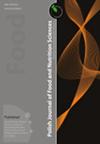不同干燥方式对速溶谷子干燥动力学、理化性质及感官品质的影响
IF 2.3
4区 农林科学
Q3 FOOD SCIENCE & TECHNOLOGY
引用次数: 2
摘要
采用微波真空干燥法(MVD)、微波热风干燥法(MHAD)、热风干燥法(HAD)和传统焙烧法(TR)制备即食谷子。评价和比较了它们对干燥动力学、理化性质和感官品质的影响。结果表明,不同干燥方式的总干燥时间不同,MVD、MHAD、HAD和TR分别为160、100、260和45 min。MVD、MHAD、HAD和TR的有效水分扩散系数(Deff)分别为6.57×10 -9 m2/s、9.80×10-9 m2/s、4.14×10-9 m2/s和6.20×10-9 m2/s。干燥导致产品颜色的L*显著降低,a*和b*显著增加。MVD、MHAD和HAD产品的再水化率和蒸煮时间相当。扫描电镜和复水化过程显示MHAD和MVD样品与had样品具有相似的结构。干燥导致总酚含量损失6.5 ~ 54.9%,总黄色色素含量损失38.4 ~ 62.2%。MVD谷子总酚含量最高(142.56 mg GAE/100 g干物质),黄色素含量最高(9.56 mg CE/kg干物质)。在感官评估中,MHAD, HAD和MVD样品的得分相当,并且都被小组成员接受,无论是干燥形式还是再水合形式。MHAD和MVD干燥时间短,产品质量好,可替代热风干燥或传统的焙烧生产即食小米。本文章由计算机程序翻译,如有差异,请以英文原文为准。
Drying Kinetics, Physicochemical Properties and Sensory Quality of the Instant Foxtail Millet as Affected by Drying Methods
The instant foxtail millet was prepared using microwave vacuum drying (MVD), microwave-hot air drying (MHAD), hot air drying (HAD) and traditional roasting (TR). Their effects on drying kinetics, physicochemical properties as well as sensory quality were evaluated and compared. Results showed that the total drying time varied with the drying method used and was about 160, 100, 260, and 45 min for MVD, MHAD, HAD and TR, respectively. The effective moisture diffusion coefficients (Deff) were 6.57×10 –9 m2/s, 9.80×10–9 m2/s, 4.14×10–9 m2/s and 6.20×10–9 m2/s for MVD, MHAD, HAD and TR, respectively. Drying resulted in a significant decrease in L* and an increase in a* and b* of the color of products. MVD, MHAD and HAD products had a comparable rehydration ratio and cooking time. Scanning electron microscopy and rehydration process revealed that MHAD and MVD samples had a similar structure with the HAD sample. Drying caused a loss of 6.5–54.9% in the total phenolic content and a loss of 38.4–62.2% in total yellow pigment content. MVD millet displayed the highest total phenolic content (142.56 mg GAE/100 g dry matter) and yellow pigment content (9.56 mg CE/kg dry matter). In sensory evaluation, MHAD, HAD and MVD samples had comparable scores and were all accepted by the panelists, either in dry or rehydrated form. MHAD and MVD can be used as an alternative to hot air drying or traditional roasting in the production of the instant millet due to shorter drying time and better product quality.
求助全文
通过发布文献求助,成功后即可免费获取论文全文。
去求助
来源期刊

Polish Journal of Food and Nutrition Sciences
FOOD SCIENCE & TECHNOLOGY-
CiteScore
4.30
自引率
12.50%
发文量
25
审稿时长
20 weeks
期刊介绍:
The Polish Journal of Food and Nutrition Sciences publishes original, basic and applied papers, reviews and short communications on fundamental and applied food research in the following Sections:
-Food Technology:
Innovative technology of food development including biotechnological and microbiological aspects
Effects of processing on food composition and nutritional value
-Food Chemistry:
Bioactive constituents of foods
Chemistry relating to major and minor components of food
Analytical methods
-Food Quality and Functionality:
Sensory methodologies
Functional properties of food
Food physics
Quality, storage and safety of food
-Nutritional Research Section:
Nutritional studies relating to major and minor components of food (excluding works related to questionnaire
surveys)
-“News” section:
Announcements of congresses
Miscellanea
 求助内容:
求助内容: 应助结果提醒方式:
应助结果提醒方式:


